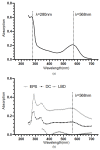Engineered Bacteriorhodopsin Film with Oriented Patterns for the Improvement of the Photoelectric Response
- PMID: 36555719
- PMCID: PMC9785767
- DOI: 10.3390/ijms232416079
Engineered Bacteriorhodopsin Film with Oriented Patterns for the Improvement of the Photoelectric Response
Abstract
The use of photosensitive proteins has become a competitive solar energy solution, owing to its pollution-free nature, high conversion efficiency, and good biocompatibility. Bacteriorhodopsin (bR) is an important light-sensitive protein that is widely used in the fabrication of photoelectronic devices. However, research on the optimization and comparison of the immobilization techniques is lacking. In this study, in order to obtain bR films with a high energy conversion efficiency, three immobilization techniques, namely dropcasting, electrophoretic sedimentation, and Langmuir-Blodgett deposition, were used to fabricate films, and their topographical and photoelectrical characteristics were compared. All three immobilization techniques can transfer bR molecules to substrates, forming functional photosensitive bR films. The absorption of the bR films at 568 nm reached the highest value of 0.3 under the EPS technique. The peak photocurrent for the EPS technique reached 5.03 nA. In addition, the EPS technique has the highest efficiency factor of 13.46, indicating that it can generate the highest value of photocurrent under the same light conditions, owing to the improved orientation, and no significant decrease in the peak photocurrent was observed after three weeks, which indicates the stability of the photoelectric response. These results indicate that the EPS technique has a great potential for the photoelectrical device fabrication and solar-energy conversion.
Keywords: bacteriorhodopsin; efficiency factor; energy conversion; immobilization technique; photoelectric response.
Conflict of interest statement
The authors declare no conflict of interest.
Figures





Similar articles
-
Thin films and assemblies of photosensitive membrane proteins and colloidal nanocrystals for engineering of hybrid materials with advanced properties.Adv Colloid Interface Sci. 2012 Nov 15;183-184:14-29. doi: 10.1016/j.cis.2012.07.003. Epub 2012 Jul 28. Adv Colloid Interface Sci. 2012. PMID: 22906866 Review.
-
Oriented assembly of bacteriorhodopsin on ZnO nanostructured electrode for enhanced photocurrent generation.Biotechnol Appl Biochem. 2015 Jul-Aug;62(4):489-93. doi: 10.1002/bab.1294. Epub 2014 Dec 30. Biotechnol Appl Biochem. 2015. PMID: 25223865
-
Enhanced photocurrent generation in bacteriorhodopsin based bio-sensitized solar cells using gel electrolyte.J Photochem Photobiol B. 2016 Sep;162:208-212. doi: 10.1016/j.jphotobiol.2016.06.044. Epub 2016 Jun 28. J Photochem Photobiol B. 2016. PMID: 27380296
-
Fabrication of oriented poly-L-lysine/bacteriorhodopsin-embedded purple membrane multilayer structure for enhanced photoelectric response.J Colloid Interface Sci. 2010 Apr 1;344(1):150-7. doi: 10.1016/j.jcis.2009.12.013. Epub 2009 Dec 6. J Colloid Interface Sci. 2010. PMID: 20056227
-
Langmuir-Blodgett films of photosensitive proteins.J Photochem Photobiol B. 1996 May;33(3):191-200. doi: 10.1016/1011-1344(96)07289-2. J Photochem Photobiol B. 1996. PMID: 8683396 Review.
References
-
- Kannan N., Vakeesan D. Solar energy for future world:—A review. Renew. Sustain. Energy Rev. 2016;62:1092–1105. doi: 10.1016/j.rser.2016.05.022. - DOI
-
- Mekhilef S., Saidur R., Safari A. A review on solar energy use in industries. Renew. Sustain. Energy Rev. 2011;15:1777–1790. doi: 10.1016/j.rser.2010.12.018. - DOI
-
- Halls J.J.M., Walsh C.A., Greenham N.C., Marseglia E.A., Friend R.H., Moratti S.C., Holmes A.B. Efficient photodiodes from interpenetrating polymer networks. Nature. 1995;376:498–500. doi: 10.1038/376498a0. - DOI
-
- Hall R. Silicon photovoltaic cells. Solid-State Electron. 1981;24:595–616. doi: 10.1016/0038-1101(81)90188-X. - DOI
-
- Köhler M., Pomaska M., Procel P., Santbergen R., Zamchiy A., Macco B., Lambertz A., Duan W., Cao P., Klingebiel B., et al. A silicon carbide-based highly transparent passivating contact for crystalline silicon solar cells approaching efficiencies of 24% Nat. Energy. 2021;6:529–537. doi: 10.1038/s41560-021-00806-9. - DOI
MeSH terms
Substances
LinkOut - more resources
Full Text Sources

